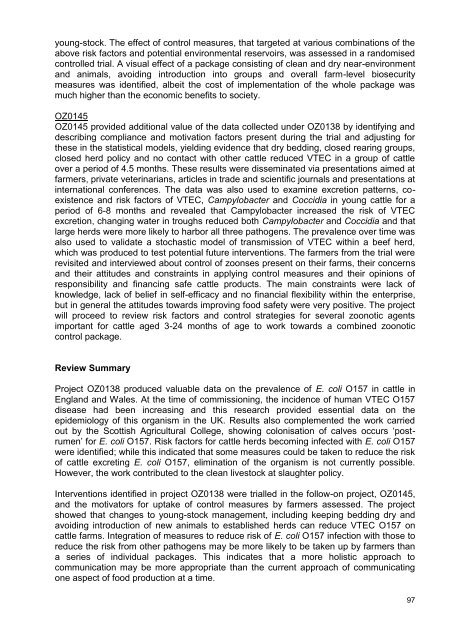Review of the Food-borne Zoonoses Research ... - ARCHIVE: Defra
Review of the Food-borne Zoonoses Research ... - ARCHIVE: Defra
Review of the Food-borne Zoonoses Research ... - ARCHIVE: Defra
You also want an ePaper? Increase the reach of your titles
YUMPU automatically turns print PDFs into web optimized ePapers that Google loves.
young-stock. The effect <strong>of</strong> control measures, that targeted at various combinations <strong>of</strong> <strong>the</strong><br />
above risk factors and potential environmental reservoirs, was assessed in a randomised<br />
controlled trial. A visual effect <strong>of</strong> a package consisting <strong>of</strong> clean and dry near-environment<br />
and animals, avoiding introduction into groups and overall farm-level biosecurity<br />
measures was identified, albeit <strong>the</strong> cost <strong>of</strong> implementation <strong>of</strong> <strong>the</strong> whole package was<br />
much higher than <strong>the</strong> economic benefits to society.<br />
OZ0145<br />
OZ0145 provided additional value <strong>of</strong> <strong>the</strong> data collected under OZ0138 by identifying and<br />
describing compliance and motivation factors present during <strong>the</strong> trial and adjusting for<br />
<strong>the</strong>se in <strong>the</strong> statistical models, yielding evidence that dry bedding, closed rearing groups,<br />
closed herd policy and no contact with o<strong>the</strong>r cattle reduced VTEC in a group <strong>of</strong> cattle<br />
over a period <strong>of</strong> 4.5 months. These results were disseminated via presentations aimed at<br />
farmers, private veterinarians, articles in trade and scientific journals and presentations at<br />
international conferences. The data was also used to examine excretion patterns, coexistence<br />
and risk factors <strong>of</strong> VTEC, Campylobacter and Coccidia in young cattle for a<br />
period <strong>of</strong> 6-8 months and revealed that Campylobacter increased <strong>the</strong> risk <strong>of</strong> VTEC<br />
excretion, changing water in troughs reduced both Campylobacter and Coccidia and that<br />
large herds were more likely to harbor all three pathogens. The prevalence over time was<br />
also used to validate a stochastic model <strong>of</strong> transmission <strong>of</strong> VTEC within a beef herd,<br />
which was produced to test potential future interventions. The farmers from <strong>the</strong> trial were<br />
revisited and interviewed about control <strong>of</strong> zoonses present on <strong>the</strong>ir farms, <strong>the</strong>ir concerns<br />
and <strong>the</strong>ir attitudes and constraints in applying control measures and <strong>the</strong>ir opinions <strong>of</strong><br />
responsibility and financing safe cattle products. The main constraints were lack <strong>of</strong><br />
knowledge, lack <strong>of</strong> belief in self-efficacy and no financial flexibility within <strong>the</strong> enterprise,<br />
but in general <strong>the</strong> attitudes towards improving food safety were very positive. The project<br />
will proceed to review risk factors and control strategies for several zoonotic agents<br />
important for cattle aged 3-24 months <strong>of</strong> age to work towards a combined zoonotic<br />
control package.<br />
<strong>Review</strong> Summary<br />
Project OZ0138 produced valuable data on <strong>the</strong> prevalence <strong>of</strong> E. coli O157 in cattle in<br />
England and Wales. At <strong>the</strong> time <strong>of</strong> commissioning, <strong>the</strong> incidence <strong>of</strong> human VTEC O157<br />
disease had been increasing and this research provided essential data on <strong>the</strong><br />
epidemiology <strong>of</strong> this organism in <strong>the</strong> UK. Results also complemented <strong>the</strong> work carried<br />
out by <strong>the</strong> Scottish Agricultural College, showing colonisation <strong>of</strong> calves occurs ‗postrumen‘<br />
for E. coli O157. Risk factors for cattle herds becoming infected with E. coli O157<br />
were identified; while this indicated that some measures could be taken to reduce <strong>the</strong> risk<br />
<strong>of</strong> cattle excreting E. coli O157, elimination <strong>of</strong> <strong>the</strong> organism is not currently possible.<br />
However, <strong>the</strong> work contributed to <strong>the</strong> clean livestock at slaughter policy.<br />
Interventions identified in project OZ0138 were trialled in <strong>the</strong> follow-on project, OZ0145,<br />
and <strong>the</strong> motivators for uptake <strong>of</strong> control measures by farmers assessed. The project<br />
showed that changes to young-stock management, including keeping bedding dry and<br />
avoiding introduction <strong>of</strong> new animals to established herds can reduce VTEC O157 on<br />
cattle farms. Integration <strong>of</strong> measures to reduce risk <strong>of</strong> E. coli O157 infection with those to<br />
reduce <strong>the</strong> risk from o<strong>the</strong>r pathogens may be more likely to be taken up by farmers than<br />
a series <strong>of</strong> individual packages. This indicates that a more holistic approach to<br />
communication may be more appropriate than <strong>the</strong> current approach <strong>of</strong> communicating<br />
one aspect <strong>of</strong> food production at a time.<br />
97

















